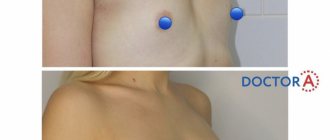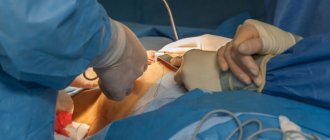What happens to the breasts during pregnancy? The mammary glands increase in size starting from the first days of pregnancy
Immediately after conception, changes begin to occur in a woman’s body that affect absolutely all organs and systems. The female breast is no exception, therefore, during the period of bearing a child, it also undergoes a number of transformations that affect its size, the condition of the glandular cells, appearance and ability to feed. What happens to the mammary glands during pregnancy? What changes in the breast are characteristic of different stages of gestation (pregnancy)?
The importance of the initial period
Despite the fact that the first month of pregnancy is quite difficult to determine, it is the most important for the health of the unborn child. It is in the first month that implantation occurs, the correctness of which determines both the future course of pregnancy and the development of the fetus. Ideally, if pregnancy is planned in advance, then even before its onset the woman adjusts her lifestyle, gives up bad habits and switches to a healthier diet. If pregnancy turns out to be a surprise, then at the first, even indirect, signs, you should switch to a healthy lifestyle as quickly as possible.
Particular attention should be paid to the nutrition of the expectant mother. Here's what the WHO Regional Office for Europe report on Healthy maternal nutrition: a better start in life says: “Inadequate maternal nutrition in the earliest stages of life, in utero and early life can have both short- and long-term consequences. impact; in particular, increase the risk of non-communicable diseases and obesity throughout later life. <…>Poor nutritional conditions before and during pregnancy can cause short-term and long-term changes in weight-height parameters, body composition and metabolic reactions of the offspring.”*
What happens to the breasts during pregnancy?
After fertilization of the egg and its attachment to the wall of the uterus, the woman’s entire body is reconstructed to a new regime, a prerequisite for which is changes in the mammary glands. Such changes include:
- an increase in the volume of the mammary glands;
- increased sensitivity and pain;
- darkening of the areolar circles (the area around the nipples);
- the appearance of discharge from the nipples;
- formation of a venous network on the chest.
The mammary glands begin to increase in size from the first days of pregnancy. On average, during the entire period of bearing a child, breasts can increase by 2-3 sizes. Therefore, at this time, a woman should pay special attention to caring for her mammary glands, which will help maintain their shape and prevent the formation of stretch marks in the future. You should use special bras and creams; it is also advisable to remember a set of physical exercises for the chest and learn how to massage.
One of the early signs of pregnancy is increased sensitivity and pain in the breast area. Often, the expectant mother notices numbness, tingling or itching of the mammary glands, which indicates their preparation for lactation. In addition, the changes extend to the nipples, which become darker along with the surrounding areolas. The diameter of the nipple circles can increase up to 5 cm, while the length of the nipples in most cases reaches 1-1.3 cm.
In the last weeks of pregnancy, a woman begins to notice the appearance of discharge from the nipples. This is how colostrum (secret) appears, which is necessary for babies in the first days of their life. If such discharge becomes abundant, it is advisable to use lactation pads. In most women, a venous network protrudes on enlarged breasts, which occurs due to increased blood flow. This goes away after childbirth and does not pose a health risk.
As a rule, pain and increased sensitivity in the breast area disappear after the first weeks of pregnancy. In later stages, a woman no longer worries about the pain associated with breast growth, but other changes appear in the form of darkening of the areolas and enlargement of the nipples2.
Join the Similac club “Growing Together!” and receive discounts, gifts and advice from experts.
Join the club →
Condition of the expectant mother in the first month of expecting a child
Symptoms of the first month of pregnancy are individual - “every pregnancy is unique”**. However, the most common signs can be identified:
- Increased fatigue, drowsiness, feeling of tiredness, even slight dizziness. The body spends energy on restructuring, and it may not be enough for usual activity.
- Lethargy and apathy. These symptoms may be caused by a natural, temporary decrease in immunity.
- Sudden mood swings. The body of the expectant mother produces progesterone, which affects the psyche and can slightly disrupt the functioning of the central nervous system.
- Problems with the gastrointestinal tract. Heartburn, constipation, bloating are also consequences of progesterone production.
- Periodic increase in temperature up to 37 °C, especially in the afternoon. And this is also one of the likely consequences of the growing level of progesterone.
- Changes in the mammary glands: engorgement and darkening of the nipples, breast enlargement. These are signs of incipient hormonal changes.
- Other common symptoms include increased sense of smell, changes in taste preferences, nausea, aching pain in the lower back, and increased frequency of urination.
Changes you can't ignore
Each woman’s body is individual, so all the changes that occur in the mammary glands also manifest themselves differently. Despite this, there are a number of alarming breast symptoms that should not be ignored under any circumstances. These include:
- the appearance of bloody discharge from the nipples, as well as secretion with an unpleasant odor or dark green color;
- severe pain in the area of the mammary glands with the formation of a lump that hurts and twitches;
- retraction of the nipples and the appearance of the so-called orange peel on the surface of the breast;
- uneven increase in mammary glands in volume, the appearance of a hard and painful area in the breast, the presence of depressions and an increase in local skin temperature over a specific area of glandular tissue.
Such pathological symptoms should never be ignored. If a problem is detected, you must immediately contact a specialist. It is important to remember that disruption of the normal development of the mammary glands during pregnancy may be a sign of a frozen pregnancy or indicate an ectopic pregnancy. In addition, the absence of changes in the breast confirms the fact of insufficient production of hormones, which carries the risk of miscarriage, the formation of inflammation in the thickness of the glandular tissue or on surfaces of the internal genital organs.
Often women do not notice changes in their breasts, and also do not pay attention to other changes associated with the growing baby in the stomach. It is important to understand that only careful attention to your body and your special situation will help you determine the presence of a problem in time and prevent troubles. Pregnancy requires careful treatment of your body, and your breasts are no exception.
Condition of the fetus in the first month of pregnancy
The embryo attaches to the uterine mucosa, which becomes looser. Neither the placenta nor the umbilical cord have yet formed; The fetus receives the substances necessary for development through the villi of the outer shell of the embryo - the chorion. Due to the absence of a placenta, which performs a barrier function, at this stage the fetus is especially vulnerable to unfavorable substances in the mother’s blood: viruses, active ingredients of drugs, nicotine, ethanol, etc. To partially protect the fetus from infection, the passage of the cervix is closed with a mucus plug .
The size of the embryo at the end of the first month is only about 1 mm. Internal organs, skin, and the central nervous system begin to form.
How long does it take to notice breast enlargement?
The glandular tissue expands under the influence of progesterone, and estrogen promotes the expansion of the milk ducts. When do these changes begin? Experts say that breasts change from the very beginning of pregnancy (more details in the article: what do breasts look like during pregnancy?). The pain appears due to a strong increase in the volume of glandular tissue, which is especially noticeable in the first 2–3 months. It is believed that by 10–12 weeks of pregnancy, the main changes in the mammary glands are completed - they are already prepared for feeding the baby, so the growth process slows down significantly.
The discomfort goes away around 12–14 weeks, when the body gets used to hormonal fluctuations. For some women, chest discomfort goes away by the 5th week, for others it continues throughout pregnancy, both of which are normal.
At the final stage of gestation, prolactin begins to be produced, which is responsible for milk production. Due to this, the alveoli are filled, and the mammary glands continue to enlarge. The breasts are at their maximum size before childbirth. The connective tissue that grows during pregnancy is transformed into fatty tissue after lactation is completed.
Since each body is individual, changes in pregnant women occur differently. For example, breasts may not change at all throughout the entire period of gestation, or will begin to grow only at 6–7 months, or will swell after childbirth. Most often, the mammary glands do not grow in women who have already given birth, but do not worry - this will not affect the quality of feeding.
Examinations carried out in the first month of pregnancy
When the expectant mother contacts the antenatal clinic, she is registered, and the obstetrician-gynecologist opens an exchange card. It will record the progress of the pregnancy, note the test results, and when sent to the maternity hospital, the card should be given to the doctor delivering the baby. A pregnant woman is prescribed a full examination, which includes a whole list of laboratory and instrumental studies:
- general analysis of urine and blood;
- blood chemistry;
- determination of group and Rh factor;
- testing for potentially dangerous infections for mother and fetus (hepatitis, HIV, syphilis, rubella, herpes, cytomegalovirus and toxoplasmosis);
- vaginal smear for microflora;
- blood pressure measurement;
- smear for oncocytogram (if more than 6 months have passed since the last examination)
- Ultrasound is recommended to be performed no earlier than three weeks after ovulation. During this period, it is already possible to determine the position of the fertilized egg, its size and shape, the number of future babies and the tone of the uterus. It is not prescribed to everyone, but only according to indications.
An important test is to measure the level of the hormone hCG (human chorionic gonadotropin, which is produced by the fetal chorionic villi) in the blood or urine. This allows you to timely detect a frozen or ectopic pregnancy, as well as establish the presence of twins. In addition, it is necessary to undergo examination by a number of specialists:
- therapist;
- dentist;
- ophthalmologist;
- otorhinolaryngologist;
- endocrinologist (according to indications);
How are women's breasts constructed?
The breast is a paired organ necessary for feeding a child. The mammary glands, as a rule, are not the same - the difference between them in a woman can normally be up to 2 sizes. The organ consists of several types of tissue:
- Glandular. It is divided into separate glands and forms so-called lobules, of which there can be from 30 to 80 pieces. Each small gland consists of microscopic tubes ending in alveoli - milk is formed in them. Some women have extra lobes that extend to the armpits, causing soreness in this area during pregnancy.
- Fatty. Its quantity depends on the characteristics of the organism. If there is a lot of adipose tissue, when a woman’s body weight changes, the volume and shape of the breast changes significantly.
- Connective. This tissue divides the gland into 15–20 large lobes.
The tubes located in the glandular tissue are connected to each other and merge at the nipple into the milk ducts. The nipple is surrounded by an areola and is distinguished by the presence of a huge number of receptors, the irritation of which stimulates the secretion of milk. In nulliparous women, the areolas are pink; after pregnancy, they darken, becoming brown. In addition, the conical shape of the nipple may change - it takes on the appearance of a cylinder.
Provoking factors
Mastopathy develops against the background of hormonal imbalances, which trigger the processes of degeneration of glandular tissue. The following reasons may lead to such changes:
- breast injuries;
- no history of pregnancy;
- age over 35 years;
- irregular sex life;
- diseases of the reproductive system;
- periodic stress;
- frequent abortions;
- bad habits.
Provoking factors trigger the disease long before pregnancy. If mastopathy was discovered after conception, the pathology developed over several years.
Features of diagnosis during pregnancy
If mastopathy is suspected during pregnancy, there are certain restrictions on diagnostics. During pregnancy, X-rays are prohibited; all research methods must be as safe as possible.
Therefore, pathology can be detected in two main ways:
- Examination - by palpation in the mammologist's office. The doctor evaluates the presence of seals, their size and location.
- Ultrasound is the only safe method of instrumental diagnostics. At 3-6 months it can be replaced by MRI.
Objectives of treatment of mastopathy during pregnancy
Treatment of mastopathy is aimed at slowing the progression of the pathology, relieving symptoms and eliminating the causative factor. During pregnancy, you cannot take hormonal medications, so the doctor will give recommendations on your daily routine and strengthening procedures. The following effects are expected from this therapy:
- pain relief;
- reduction of compactions;
- resorption of cysts;
- restoration of glandular tissue;
- stabilization of hormonal levels.
To solve all problems, you need to carry out therapy for a long time and follow all the doctor’s recommendations. The first results from conservative treatment are observed several months after its start.
Is mastopathy a contraindication for pregnancy?
Planning pregnancy is an important stage in the life of every woman. If mastopathy is diagnosed, conception and childbirth will benefit:
- as the child develops, hormones in the woman’s body stabilize, which has a beneficial effect on the physiology of the mammary gland;
- after childbirth, secretion starts - all toxins and impurities are washed out with mother's milk, and congestion is eliminated.
Mastopathy is not a contraindication for pregnancy, but is considered an effective prevention. When planning it, it is recommended to visit your doctor.
Labor with lumps in the chest
Most patients do not notice a worsening of the clinical manifestations of mastopathy during labor; pronounced symptoms are disturbing only in severe forms of mastopathy:
- increased pain of a bursting nature;
- fever in the first days after the birth of the child.
Such clinical manifestations rarely occur; usually, before giving birth, a woman undergoes a treatment program as recommended by a doctor. If your health worsens, symptomatic therapy is prescribed.
Breast implants and fertility
The process of conceiving a child, in which the fertility of the expectant mother plays a vital role, cannot be disrupted due to the installation of implants. To date, silicone implants have not been found to have any mechanisms that could have any effect on a woman’s reproductive function. In some cases, before undergoing augmentation mammoplasty, women lose excess weight. This helps to achieve a more perfect and aesthetically attractive result after plastic surgery. However, a woman’s health and her ability to conceive may depend on weight loss methods. Aggressive weight loss methods can have a very hard impact on your hormonal levels. However, the process of installing implants, as well as the silicone prostheses themselves, will not play any role in this.










